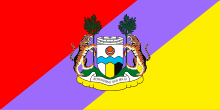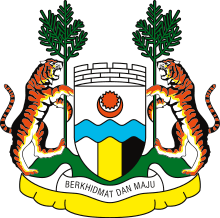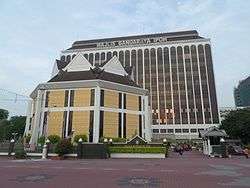Ipoh
| Ipoh | |||
|---|---|---|---|
| City and State Capital | |||
| Other transcription(s) | |||
| • Chinese | 怡保 | ||
| • Tamil | ஈப்போ | ||
| • Jawi | إڤوه | ||
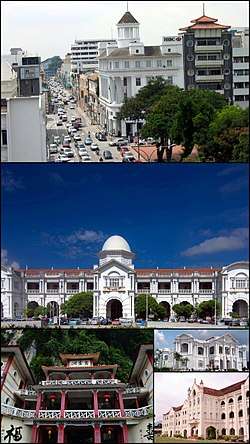 Clockwise from top: Jalan Tun Sambanthan within the Old Town, Railway Station, City Hall, St. Michael's Institution, Sam Poh Tong Cave Temple | |||
| |||
| Nickname(s): City of Millionaires, Bougainvillea City, Silver Valley | |||
|
Motto(s): Ipoh Bersih, Hijau dan Maju | |||
 Ipoh  Ipoh Ipoh (Peninsular Malaysia) | |||
| Coordinates: 4°35′50″N 101°04′30″E / 4.59722°N 101.07500°ECoordinates: 4°35′50″N 101°04′30″E / 4.59722°N 101.07500°E | |||
| Country |
| ||
| State |
| ||
| Establishment | Around 1880 | ||
| Granted States Capital status | 31 May 1937 | ||
| Granted Municipality status | 31 May 1962 | ||
| Granted City status | 27 May 1988 | ||
| Government | |||
| • Mayor | Zamri Man | ||
| Area | |||
| • City and State Capital | 643 km2 (248 sq mi) | ||
| Elevation | 21.95 m (72 ft) | ||
| Population (2010) | |||
| • City and State Capital | 657,892 | ||
| • Density | 1,023/km2 (2,650/sq mi) | ||
| • Metro | 737,861[1] | ||
| Time zone | UTC+8 (MST) | ||
| • Summer (DST) | Not observed | ||
| Postcode | 30xxx, 31xxx | ||
| Area code(s) | 05 | ||
| Website |
mbi | ||
Ipoh (/ˈiːpoʊ/) is the capital city of the Malaysian state of Perak. Located by the Kinta River, it is nearly 180 km (110 mi) north of Kuala Lumpur and 123 km (76 mi) southeast of George Town in neighbouring Penang. As of 2010, Ipoh contained a population of 657,892, making it the third largest city in Malaysia by population.[2]
Originally a village, Ipoh began to grow rapidly in the 1880s after huge deposits of tin were discovered within its vicinity.[3] By 1895, it was the second largest town within the Federated Malay States, which also consisted of Selangor, Negeri Sembilan and Pahang.[4] Ipoh was declared a city in 1988.[3][4] However, following the depletion of its tin deposits and the collapse of tin prices in the 1970s, the city suffered decades of decline and neglect.[5][6][7][8]
In recent years, Ipoh's popularity as a tourist destination has been significantly boosted by efforts to conserve its British colonial-era architecture.[7][8] The city is also well known for its cuisine and natural attractions, such as its limestone hills and caves within which Buddhist temples were built.[9] In addition, Ipoh has managed to maintain its reputation as one of the cleanest cities in Malaysia.[10]
Ipoh's location between Kuala Lumpur and George Town has made it a major land transportation hub within West Malaysia, with both the Malayan Railway's West Coast Line and the North-South Expressway cutting through the city. Aside from the land transportation links, Ipoh is also served by the Sultan Azlan Shah Airport.
Ipoh is known as the Hipster Capital of Malaysia by various tourism rating and official agencies[11][12][13][14].
History
Ipoh grew out from the Malay village of Palau along the banks of the Kinta River in the 1880s.[3] Its geographic location in the rich tin-bearing valley of the Kinta River made it a natural centre of growth.
The Great Fire of Ipoh in 1892 destroyed over half the town, but also presented an opportunity to rebuild the town in a more orderly grid pattern. Ipoh was subsequently rebuilt in time for the second tin rush and grew rapidly as a result of the booming tin mining industry, particularly in the 1920s and 1930s.
A local Hakka miner, millionaire Yau Tet Shin, started developing a large tract of the town in the early 1930s, today known as the 'New Town', from the eastern bank of the Kinta River to Greentown.[15] In 1937, Ipoh was made the capital of Perak, replacing Taiping.
Ipoh was invaded by the Japanese on 15 December 1941. In March 1942, the Japanese Civil Administration or Perak Shu Seicho was set up at the St. Michael's Institution. After the liberation of Malaya by British forces, Ipoh remained the capital of Perak to this day.[16]
The decline of the tin mining industry during the latter half of the 20th century caused the growth of Ipoh to stagnate. With the closure of the tin mines, its urban population was forced to seek employment in other cities within Malaysia. In spite of this, Ipoh remains one of the largest cities in Malaysia in terms of population, with tourism now a main driver of the city's economy.[17]
Ipoh gained Municipal status in 1962, and in 1988, was declared a city by the then Sultan of Perak, Sultan Azlan Shah.[3]
Geography
Topography
Ipoh is in the state of Perak, which is in the northern part of Peninsular Malaysia. The city is in the middle of the Kinta Valley, on the bank of the Kinta River and the confluence of smaller rivers, Sungai Pinji and Sungai Pari. The city is surrounded by limestone hills, which can be found around suburban areas to the northeast, east and southeast.[18]
The Kledang mountain range stretches from the north to the west of the city. This range runs parallel to the Bintang mountain range with the Perak River flowing on its left bank and the Kinta River to its right. This range is interrupted to the north of Ipoh by a tributary of the Perak River called the Pelus River, which is sourced from the Titiwangsa mountain range, which runs to the east of Ipoh.[19]
Climate
Ipoh features a tropical rainforest climate. Temperatures are about the same throughout the year, showing little variation. The city's average temperature is 28 °C (82 °F). Ipoh sees high precipitation throughout the year with an average of 200 mm (7.9 in) of rain each month and averaging 2,427.9 mm (95.59 in) of rain per year. The wettest month is October where on average 297.2 mm (11.70 in) of rain is seen. Ipoh's driest month is January which has 132.3 mm (5.21 in) of rain fall on average.
| Climate data for Ipoh | |||||||||||||
|---|---|---|---|---|---|---|---|---|---|---|---|---|---|
| Month | Jan | Feb | Mar | Apr | May | Jun | Jul | Aug | Sep | Oct | Nov | Dec | Year |
| Average high °C (°F) | 32.9 (91.2) |
33.7 (92.7) |
33.9 (93) |
33.7 (92.7) |
33.5 (92.3) |
33.3 (91.9) |
33.0 (91.4) |
33.0 (91.4) |
32.5 (90.5) |
32.4 (90.3) |
32.1 (89.8) |
32.1 (89.8) |
33.0 (91.4) |
| Average low °C (°F) | 22.6 (72.7) |
23.0 (73.4) |
23.4 (74.1) |
23.9 (75) |
24.0 (75.2) |
23.7 (74.7) |
23.2 (73.8) |
23.3 (73.9) |
23.2 (73.8) |
23.1 (73.6) |
23.1 (73.6) |
22.8 (73) |
23.3 (73.9) |
| Average rainfall mm (inches) | 132.3 (5.209) |
149.8 (5.898) |
169.9 (6.689) |
259.1 (10.201) |
210.9 (8.303) |
151.8 (5.976) |
156.6 (6.165) |
157.8 (6.213) |
216.0 (8.504) |
297.2 (11.701) |
275.4 (10.843) |
251.1 (9.886) |
2,427.9 (95.587) |
| Average rainy days (≥ 1.0 mm) | 9 | 10 | 12 | 14 | 14 | 10 | 10 | 12 | 15 | 18 | 18 | 15 | 157 |
| Source: World Meteorological Organisation[20] | |||||||||||||
Limestone caves

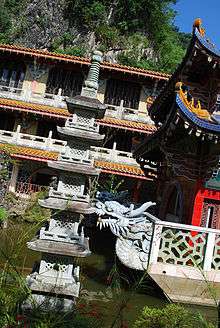
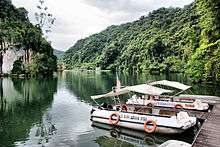
Limestone outcrops rise on the outskirts of Ipoh. There are many caves in these outcrops; cave temples are built in some.[21] Sam Poh Tong is a notable one along with Kek Lok Tong (Chinese: 極樂洞; Cavern of Utmost Happiness), which lies on the other side of the same outcrop. It is accessible through the Gunung Rapat housing area. It has a clean, quiet and cool environment. Other cave temples in Ipoh include Ling Sen Tong, Nan Tian Tong, Kwan Yin Tong and Perak Tong.
Gua Tempurung, near Gopeng south of Ipoh, is a show cave open to the public and popular among spelunkers. More than 3 km (1.9 mi) long, it is one of the longest caves in Peninsular Malaysia. Part of it has been developed with electric lighting and walkways, and there are tours of different lengths and difficulty. A river passage runs about 1.6 km (0.99 mi) through the hill. There are five very large chambers and some stalactites and stalagmites.
Cuisine
Ipoh has a vibrant food scene with a vast proliferation of hawker centres and restaurants. It is well known for dishes such as "Sar Hor Fun" (Chinese: 沙河粉) a complete one-dish rice noodle meal with prawn, meat, fish, vegetables and a savoury sauce. Other well known dishes from Ipoh include "Hor Hee", flat white rice noodles served with fish cakes and/or fish balls, "Nga Choi Kai" (Chinese: 芽菜鸡), chicken with soy sauce and beansprouts topped with pepper,"Kai Shi Hor Fun" (Chinese: 鸡丝河粉) rice noodles with Chicken, "Hakka Mee" (Chinese: 客家麵), yellow rice noodles served with mince meat (pork) sauce, , "Tau Fu Fa", soybean pudding, and Ipoh's famous pastry "Heong Peng" (Chinese: 香餅), literally translated to "fragrant biscuit". The city is well known in Malaysia for its "Ipoh white coffee" where the coffee beans are roasted with palm-oil margarine and the resulting coffee is served with condensed milk. Ipoh is also famous for its fresh fruits such as Pomelo, Durian and Seedless Guava.
In recent years Ipoh has seen an increase in international restaurants, bars and gastropubs have become popular with locals and tourists.[22]
Economy
The early history Ipoh as a settlement was due to its mining industry although it was playing second fiddle to Gopeng, some 19 km / 12 miles to the south. Ipoh was once, one of the richest cities in Malaysia as well as South East Asia back in the days when tin was king. During the 1980s when tin prices collapsed, the economy of Ipoh was hit particularly hard. However, recently the city gain some momentum. By 2017, the city will open the first Movie Animation Theme Park (MAPS), which is the first ever in South East Asia. Tourism is booming in the city, and many shops in old town Ipoh is being transform into chic café. The city of Ipoh also host some big multi national corporations. Kuala Lumpur Kepong (KLK) Berhad, a palm oil company, which is also among the top 15 biggest companies in Malaysia (By revenue) has its headquarters in Ipoh. Batu Kawan Berhad (Which is the biggest shareholder of KLK), an investment company also has its headquarters in Malaysia. Hovid Berhad, a pharmaceutical company, which is also the first Malaysian companies to introduce generic drugs overseas also has its headquarters in Ipoh. Ipoh also is well known for its white coffee. Old Town Berhad, which is a food & beverage public listed company, specializing in white coffee has its headquarters in Ipoh. There are a few other public listed companies in Ipoh such as Perak Transit Berhad, Tasek Cement Berhad, DKLS Industries Berhad, Wellcall Holding Berhad, Rubberex Berhad, Perak Corp, etc. Ipoh also host some foreign multi national companies Malaysian headquarters. Some of the foreign MNC's in Ipoh is, Finisar, Voith, ITL Asia pacific, Sagami Manufacturers, etc.
Cityscape

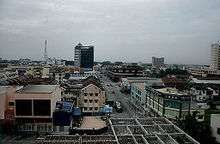
The Old Town
The Old Town is west of the Kinta River. There is a vibrant commercial district with many historical 'shop-houses' centred around Leech Street (Chinese: 烈治街; now Jalan Bandar Timah). Other notable features include:
- Ipoh railway station in neo-classical/Edwardian Baroque style nicknamed the "Taj Mahal of Ipoh".
- Ipoh Town Hall, an Edwardian Baroque municipal building located across the road from the Railway Station.
- Padang Ipoh or Ipoh Field is on Jalan S.P. Seenivasagam. The field is surrounded by historic buildings that feature classic colonial architecture, including the mock-Tudor style Ipoh Club, FMS Bar, HSBC Building and the St Michael's Institution secondary school.
- The Anglo-Chinese School, Ipoh, officially named SMK Methodist (ACS), is located along Lahat Road.
- Sekolah Menengah Kebangsaan Anderson is the most well-known secondary school with more than 100 years of history, located beside the General Hospital of Ipoh. This school has been producing numerous of figures in the country.
- St. Michael's Institution, Ipoh, is a public secondary school in Ipoh, Perak, Malaysia. It is situated on Jalan S. P. Seenivasagam, formerly Clayton Road.
- Han Chin Pet Soo, the Hakka Tin Miner's Club, located on Jalan Bijeh Timah (formerly Treacher Street) has been restored and turned into Malaysia's First Hakka Tin Mining Museum.
- Muzium Darul Ridzuan is a historical museum of Perak, in a pretty former tin-mining tycoon's mansion on Jalan Kuala Kangsar.
- Concubine Lane or better known locally as Yi Lai Hong in Cantonese is a narrow and small lane located off Jalan Bandar Timah (Leech Street) in Old Town, Ipoh. It now has different restaurants, souvenir and gift shops and an entirely respectable hotel. To some locals, Concubine Lane is already becoming too busy.
- Ipoh wall art murals drawn by talented street art artists clearly breathes in new life into Ipoh Old Town city. The murals do relive a sense of nostalgic moments related to Ipoh’s heritage and culture. It is now a popular tourist attraction, adding more crowns to Ipoh apart from being a food paradise.
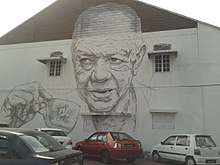
- Birch Memorial Clock Tower is a popular historical landmark which is located near the Ipoh State Mosque or commonly known as Sultan Idris Shah II Mosque. The clock tower was built to commemorate James W. W. Birch, the first British Resident in Perak who was killed on 2 November 1875 at Pasir Salak.
The New Town

The so-called New Town, to the east of the Kinta River, was developed by Yau Tet Shin around 1908.[15] The New Town houses the Perak Medical University and Ipoh City Hall building, among others. There are numerous shops, shopping malls, and hotels.
D. R. Seenivasagam Park (Coronation Park), located in the heart of Ipoh (New Town), is known for its scenic beauty and recreational facilities. It comprises recreational fields, an artificial lake filled with fish, a nursery for potted plants and a children's traffic playground. The latest addition is the newly landscaped Japanese garden featuring a Japanese carp pond.
Sports
For golf, the courses are the Royal Perak Golf Club off Jalan Sultan Azlan Shah (Tiger Lane), the Meru Golf Club in Jelapang, and Clearwater Sanctuary Golf Club en route to Batu Gajah.
Other sports venues include the Kilat Club in Pasir Pinji, Ipoh Field (Padang Ipoh) in the Old Town, the Polo Grounds, and the Iskandar Polo Club, in Ampang Baru.
The Sultan Azlan Shah Cup is an annual international men's field hockey tournament held in Ipoh.
Ipoh has a fully equipped sports complex known as Kompleks Sukan MBI or MBI Sports Complex.
Among the facilities located within the Complex is the Stadium Perak or Perak Stadium. Perak Stadium is the home of Perak The Bos Gaurus who playing in Malaysia Super League.
Governance
The Ipoh City Council governs the city. Datuk Zamri Man, appointed in August 2015, is the current mayor of Ipoh.[23]
Ipoh is divided into two parliamentary constituencies: Ipoh Barat (Ipoh West) and Ipoh Timur (Ipoh East). The parliamentary seat for Ipoh Timur is held by DAP Representative, Su Keong Siong, which was formerly held by Lim Kit Siang while the seat for Ipoh Barat is held by fellow DAP leader, M. Kulasegaran.[24]
Demographics
Ipoh remains one of Malaysia's largest cities. It is the third largest city in Malaysia. As of 2010, the municipal area of Ipoh has a population of 657,892.[25] It ranks as the seventh most populous urban centre in Malaysia (2010).[25]
The following is based on Department of Statistics Malaysia 2010 census.[25]
| Ethnic groups in Ipoh, 2010 | ||
|---|---|---|
| Ethnicity | Population | Percentage |
| Chinese | 290,165 | 44.11% |
| Bumiputera | 253,592 | 38.55% |
| Indian | 92,587 | 14.07% |
| Others | 1,559 | 0.2% |
| Non-Malaysian | 19,989 | 3.04% |
Toponymy
The name Ipoh is derived from a local tree, Pohon Epu or now more commonly known as Pokok Ipoh. The sap of this plant is poisonous and was used by Orang Asli (indigenous peoples in Malay) to coat the tips of the darts of their blowpipes for hunting.
Transport
- Trunk roads: The old interstate Route



- Highway: The new North–South Expressway

- Train: Ipoh's railway station is operated by Keretapi Tanah Melayu (KTM) and is in the Old Town (however, it does not have intra-city travel like in Kuala Lumpur). The railway only connects Ipoh with neighbouring towns and cities. The station is a stately building, referred to by locals as the 'Taj Mahal' of Ipoh. KTM Intercity began the Shuttle Train Service between Kuala Lumpur and Ipoh from 1 December 2008 while the modern Electric Train System (ETS) shuttle began from 12 August 2010 with average 145 km/h (90 mph) speed, plying Ipoh-Seremban route, cut the travelling distance between Ipoh and Kuala Lumpur into 120 minutes. There are 10 dedicated shuttle train services between these two cities daily which begins at 5 am from both the stations. Travel time between the cities was expected to be reduced from three hours to two hours and fifteen minutes when the new set of EMU trains arrived in mid-2009.[26]
- Bus: The inter-city bus terminal is located at Amanjaya Integrated Bus Terminal in Bandar Meru Raya, just north of the city.
- Air: the Sultan Azlan Shah Airport is the only airport in Ipoh. It is near Gunung Rapat. Domestic flights and international ones are available. Scoot provides daily flight out of Ipoh to Singapore Changi Airport. Firefly provides two daily flights out of Ipoh to Singapore Changi Airport while Batik Air Malaysia provides daily flights to Johor Bahru and four flights to Medan weekly.
Education
This is a list of schools in Ipoh, Perak.
- Sekolah Menengah Kebangsaan Tanjung Rambutan
- Sekolah Menengah Kebangsaan Seri Puteri
- Sekolah Jenis Kebangsaan(T)ST.Philomena Convent,Ipoh
- Sekolah Kebangsaan Dato Panglima'Kinta,Ipoh
- Sekolah Jenis Kebangsaan (C) Yuk Choy, Ipoh
- SMJK Yuk Choy, Ipoh
- Tarcisian Convent School, Ipoh (TCS)
- Anderson School, Ipoh
- Anglo-Chinese School, Ipoh
- Sekolah Tuanku Abdul Rahman (STAR), Ipoh
- St. Michael's Institution, Ipoh
- SMK Jalan Tasek, Ipoh
- Methodist Girls Secondary School (MGS), Ipoh
- Perak Girls Secondary School (PGS), Ipoh
- SMK Main Convent, Ipoh
- Wesley Methodist School, Ipoh
- Ipoh International School (Private)
- Fairview International School, Ipoh
- Perak Yuk Choy High School (Private)
- Poi Lam High School (Private) 怡保培南独立中学
- Shen Jai High School, Ipoh 怡保深斋中学
- Sekolah Jenis Kebangsaan (TAMIL) Kerajaan,Sungai Pari,Ipoh
- Sekolah Jenis Kebangsaan (TAMIL) Gunung Rapat, Ipoh
- Sekolah Jenis Kebangsaan (TAMIL) Perak Sangeetha Sabha, Ipoh
- SMK Rapat Setia, Ipoh
- SMK Jalan Pasir Puteh, Ipoh
- Sekolah Jenis Kebangsaan (C) Poi Lam, Ipoh
- SMK Seri Keledang,Ipoh
- SMK Menglembu,Ipoh
- SMJK Poi Lam, Ipoh
- Sekolah Jenis Kebangsaan (C) Sam Tet, Ipoh
- SMJK Sam Tet, Ipoh
- SMK Dato Ahmad Said
- Sekolah Jenis Kebangsaan Ave Maria Convent, Ipoh
- SMJK Ave Maria Convent, Ipoh
- Sekolah Jenis Kebangsaan (C) Wan Hwa (1)
- Sekolah Jenis Kebangsaan (C) Wan Hwa (2)
- Sekolah Kebangsaan (ACS), Ipoh
- Sekolah Kebangsaan (P) Methodist, Ipoh
- Sekolah Kebangsaan Haji Mahmud Chemor, Ipoh
- Sekolah Kebangsaan Kuala Pari, Ipoh
- Sekolah Kebangsaan Jalan Pegoh
- Sekolah Kebangsaan Jelapang
- Sekolah Kebangsaan Raja Ekram, Ipoh
- SMK Raja Perempuan, Ipoh (RPS) Royal Princess School "Cluster School"
- SRK Raja Perempuan, Ipoh (RPS)
- Sekolah Kebangsaan Seri Ampang, Ipoh
- Sekolah Kebangsaan St. Michael's Institution (1), Ipoh
- Sekolah Kebangsaan St. Michael's Institution (2), Ipoh
- Sekolah Jenis Kebangsaan (C) Chung Shan
Theme Parks
There are several theme parks in Ipoh, including the Tambun Lost World[27] and Movies Animated Park Studios.[28]
Notable people
Film and Television:
Music:
- Michael Wong
- Jamal Abdillah
- Shila Amzah
- Ning Baizura
- Francissca Peter
- Sam Chin Neng of Fuying & Sam
Sports: (Badminton):
Sports (Football):
Sports (Others):
- Tony Underwood (Rugby)
- Nur Suryani Mohd Taibi (Sports shooting)
- Leong Mun Yee (Diving)
Business:
- David Ho Sue San of Hovid Berhad & Carotech Berhad,
- Lee Loy Seng (founder of Kuala Lumpur Kepong Berhad),
- Dr. Wong Jeh Shyan CEO of CommerceNet Singapore Limited,
- Koon Yew Yin Founder of IJM Corporation Bhd and Gamuda Berhad
Politics:
- Yeoh Ghim Seng
- Dr Yeoh Eng Kiong
- S. J. V. Chelvanayakam
- Ahmad Husni Hanadzlah
- D. R. Seenivasagam
- Lim Keng Yaik
- Lee Lam Thye
Historical:
- Yusof bin Ishak (president of Singapore)
- Leong Sin Nam
- Wu Lien-teh
- Foo Choo Choon
- Leong Fee
- Chung Thye Phin
- Eu Tong Sen
Experts and Academicians:
- Lam Wei Haur (Professor Dr in Science)
- Tham Kuen Wei (Real Estate Economist & Feng Shui Consultant)
Other:
- Chan Sek Keong (Chief Justice of Singapore)
- Lat (cartoonist)
- Huen Su Yin (cake decorating)
Film and television
Movies filmed in Ipoh include:
- 1992: Indochine
- 1999: Anna and the King
- 2004: Tun Tan Cheng Lock
- 2005: Sepet
- 2005: Gubra
- 2006: After This Our Exile (Chinese 父子)
- 2006: Goodbye Boys
- 2006: Lust, Caution (Chinese: 色,戒)
- 2015: Blackhat
International relations
Sister cities
Ipoh currently has two sister cities:
See also
References
- ↑ "Archived copy" (PDF). Archived from the original (PDF) on 21 May 2012. Retrieved 2015-03-21.
- ↑ "Population Distribution by Local Authority Areas and Mukims, 2010 (page 1 & 8)" (PDF). Department of Statistics, Malaysia. Archived from the original (PDF) on 5 February 2015. Retrieved 19 July 2013.
- 1 2 3 4 "The History of Ipoh" (PDF).
- 1 2 "Info Ipoh: Halaman 2 dari 2 | Portal Rasmi Majlis Bandaraya Ipoh (MBI)". www.mbi.gov.my. Retrieved 2017-08-21.
- ↑ Tam, Susan. "Ipoh - Malaysia | The Star Online". Retrieved 2017-08-21.
- ↑ Tan, Peter (2015-02-21). "The city that tin built". BorneoPost Online | Borneo , Malaysia, Sarawak Daily News. Retrieved 2017-08-21.
- 1 2 hermes (2016-03-22). "Sleepy Ipoh awakens". The Straits Times. Retrieved 2017-08-21.
- 1 2 "Old Town restored to rightful place in history of Ipoh". www.theedgeproperty.com.my. Retrieved 2017-08-21.
- ↑ net, powered by iosc dot. "Ipoh Echo | Caves of the Kinta Valley". IpohEcho.com.my. Retrieved 2017-08-21.
- ↑ "Ipoh is Malaysia's cleanest city - Nation | The Star Online". www.thestar.com.my. Retrieved 2017-08-21.
- ↑ "Malay Mail - Ipoh Hipster Town Image". The Malay Mail.
- ↑ "SAYS". SAYS DOT COM.
- ↑ "The Star Malaysia". The Star Malaysia.
- ↑ "Time Travel Turtle". Time Travel Turtle.
- 1 2 Ipohworld’s World » Yau Tet Shin’s New Town Under Construction 1908. Ipohworld.org. Retrieved 27 September 2013.
- ↑ Khoo Salma Nasution & Abdur-Razzaq Lubis, Kinta Valley: Pioneering Malaysia's Modern Development, Ipoh: Perak Academy, 2005. pp. 273–292
- ↑ "Ipoh History Facts and Timeline: Ipoh, Perak, Malaysia". www.world-guides.com. Retrieved 2017-02-02.
- ↑ "Limestone Hills (Bukit Batu Kapur), Ipoh, PERAK – Malaysia Travel Review". Malaysiahotelreview.com. Retrieved 10 December 2013.
- ↑ Jacq-Hergoualc'h, Michel; Victoria Hobson (September 2002). The Malay Peninsula: Crossroads of the Maritime Silk Road (100 BC – 1300 AD). BRILL. ISBN 90-04-11973-6.
- ↑ "World Weather Information Service – Ipoh". World Meteorological Organisation. Retrieved 7 May 2014.
- ↑ "Home". Cavesofmalaysia.com. Retrieved 10 December 2013.
- ↑ "Ipoh's bars, gastropubs and nightlife". Travel-Tourist-Information-Guide.com. Retrieved 2016-10-08.
- ↑ "New mayor for Ipoh sworn in – Community | The Star Online". The Star. Malaysia. Retrieved 11 November 2015.
- ↑
- 1 2 3 "Population Distribution by Local Authority Areas and Mukims, 2010" (PDF). Department of Statistics Malaysia. Archived from the original (PDF) on 27 February 2012.
- ↑ "Malaysia / Perak / The Ipoh Railway Station". Cockatoo.com. 14 November 2011. Archived from the original on 19 January 2013. Retrieved 10 December 2013.
- ↑ "Lost World of Tambun Ipoh". https://sunwaylostworldoftambun.com/. External link in
|website=(help) - ↑ "Movies Animation Park, Ipoh Official Website".
- ↑ "Guangxi signed cooperation project of US$400 million with Malaysia". Ministry of Commerce, People's Republic of China. 6 April 2005. Archived from the original on 20 December 2015. Retrieved 20 December 2015.
- ↑ "Exchange with sister cities". Fukuoka City. 23 April 2009. Archived from the original on 20 December 2015. Retrieved 20 December 2015.
External links
| Library resources about Ipoh |
| Wikimedia Commons has media related to Ipoh. |

- Ipoh Tourism Board Official Website
